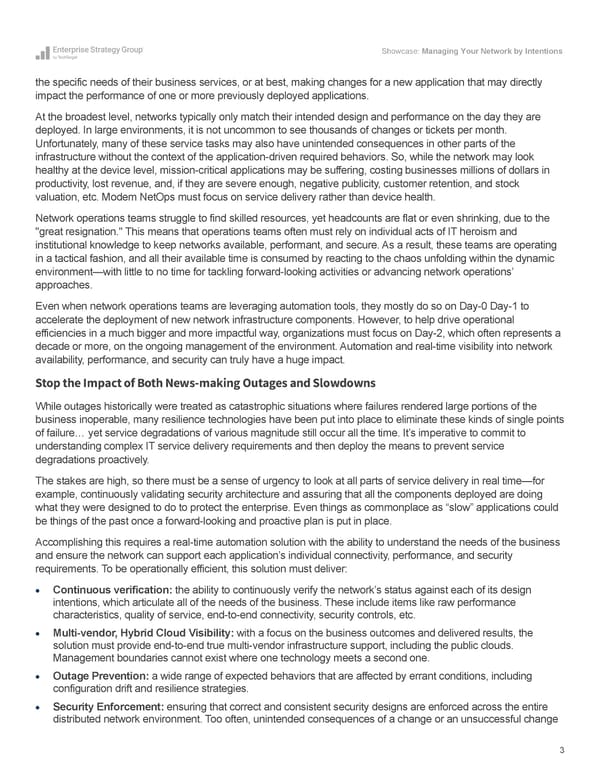Showcase: Managing Your Network by Intentions the specific needs of their business services, or at best, making changes for a new application that may directly impact the performance of one or more previously deployed applications. At the broadest level, networks typically only match their intended design and performance on the day they are deployed. In large environments, it is not uncommon to see thousands of changes or tickets per month. Unfortunately, many of these service tasks may also have unintended consequences in other parts of the infrastructure without the context of the application-driven required behaviors. So, while the network may look healthy at the device level, mission-critical applications may be suffering, costing businesses millions of dollars in productivity, lost revenue, and, if they are severe enough, negative publicity, customer retention, and stock valuation, etc. Modem NetOps must focus on service delivery rather than device health. Network operations teams struggle to find skilled resources, yet headcounts are flat or even shrinking, due to the "great resignation." This means that operations teams often must rely on individual acts of IT heroism and institutional knowledge to keep networks available, performant, and secure. As a result, these teams are operating in a tactical fashion, and all their available time is consumed by reacting to the chaos unfolding within the dynamic environment—with little to no time for tackling forward-looking activities or advancing network operations’ approaches. Even when network operations teams are leveraging automation tools, they mostly do so on Day-0 Day-1 to accelerate the deployment of new network infrastructure components. However, to help drive operational efficiencies in a much bigger and more impactful way, organizations must focus on Day-2, which often represents a decade or more, on the ongoing management of the environment. Automation and real-time visibility into network availability, performance, and security can truly have a huge impact. Stop the Impact of Both News-making Outages and Slowdowns While outages historically were treated as catastrophic situations where failures rendered large portions of the business inoperable, many resilience technologies have been put into place to eliminate these kinds of single points of failure… yet service degradations of various magnitude still occur all the time. It’s imperative to commit to understanding complex IT service delivery requirements and then deploy the means to prevent service degradations proactively. The stakes are high, so there must be a sense of urgency to look at all parts of service delivery in real time—for example, continuously validating security architecture and assuring that all the components deployed are doing what they were designed to do to protect the enterprise. Even things as commonplace as “slow” applications could be things of the past once a forward-looking and proactive plan is put in place. Accomplishing this requires a real-time automation solution with the ability to understand the needs of the business and ensure the network can support each application’s individual connectivity, performance, and security requirements. To be operationally efficient, this solution must deliver: • Continuous verification: the ability to continuously verify the network’s status against each of its design intentions, which articulate all of the needs of the business. These include items like raw performance characteristics, quality of service, end-to-end connectivity, security controls, etc. • Multi-vendor, Hybrid Cloud Visibility: with a focus on the business outcomes and delivered results, the solution must provide end-to-end true multi-vendor infrastructure support, including the public clouds. Management boundaries cannot exist where one technology meets a second one. • Outage Prevention: a wide range of expected behaviors that are affected by errant conditions, including configuration drift and resilience strategies. • Security Enforcement: ensuring that correct and consistent security designs are enforced across the entire distributed network environment. Too often, unintended consequences of a change or an unsuccessful change 3
 ESG Showcase NetBrain Network Intent Jan 2023 Page 2 Page 4
ESG Showcase NetBrain Network Intent Jan 2023 Page 2 Page 4